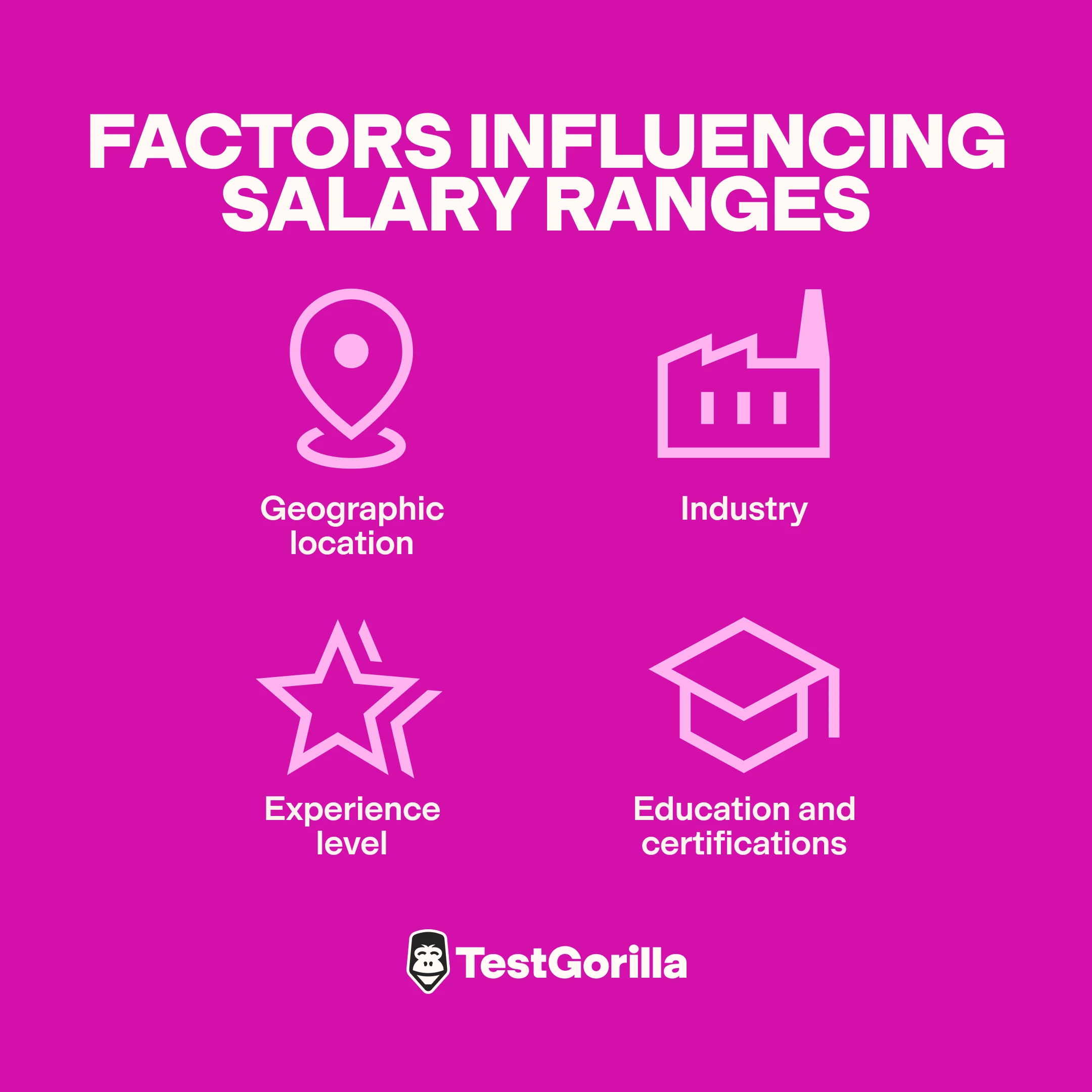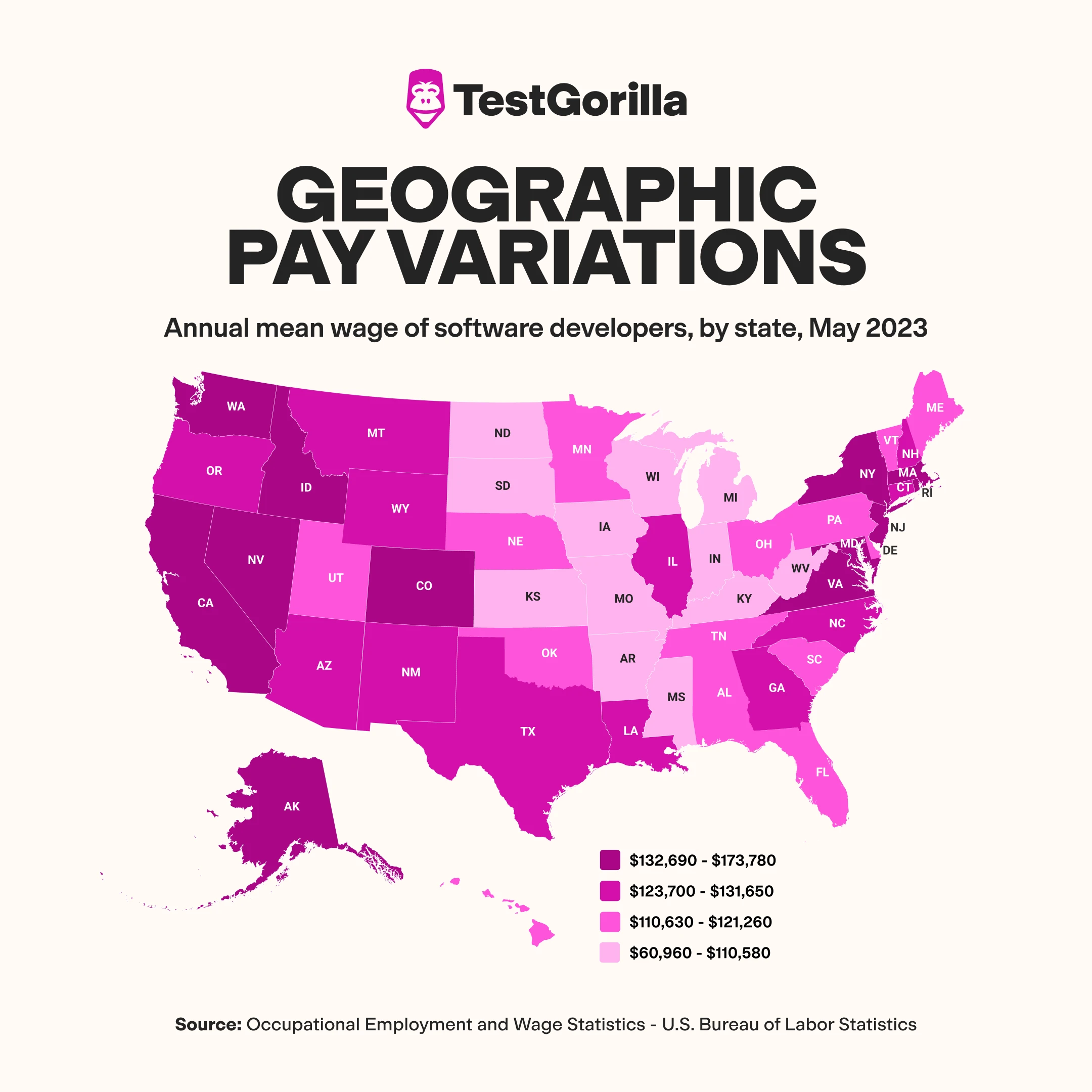What to pay a software developer
Figuring out what to pay a software developer can be tricky. If you're unsure about salary benchmarks or the different expectations for junior and senior roles, it’s easy to end up overpaying or underpaying. More pressure is added for small businesses competing with big companies for top talent, but with a lower budget.
To save you time and worry, we’ve done the research for you. We break down U.S. national salary stats for software developers, explain what influences their pay, and share tips to help you assess candidates so you can figure out exactly how much they’re worth.
Table of contents
How we researched this topic
For this article, we pulled data from the US Bureau of Labor Statistics’ Occupational Employment and Wages, May 2023 report, which includes detailed info on software developer salaries under category 15-1252. This gave us a solid look at salary trends, regional differences, and what developers earn in different industries across the U.S.
Key takeaways
Software developers in the U.S. make a median salary of $132,270, with top earners above $208,000, depending on experience, industry, and location.
The median shows what most developers make, while the average can be skewed by high earners. Both give insight into pay trends.
Location, industry, experience, and education all affect pay. Tech and finance roles in high-cost areas usually pay more.
Benefits like health insurance, 401(k)s, stock options, and remote work add value to developer compensation.
Use skills assessments and coding tests to get a clear picture of candidates’ abilities and make fair pay decisions.
National salary statistics for software developers
Pay metric | Annual salary ($) | Hourly wage ($) |
Median | $ 132,270 | $63.59 |
Mean | $ 138,110 | $66.40 |
Top 10% earners | $208,620 | $100.30 |
Bottom 10% earners | $77,020 | $37.03 |
Median salary vs. mean salary
When looking at salaries, two key numbers come up often: the median and the mean. Each one tells a slightly different story about what people are actually earning.
Median salary: This is the middle point in a list of salaries, where half the salaries are lower, and half are higher. It’s useful because it shows what a typical person in that role might make, especially when some people make a lot more or less than most.
Mean (average) salary: This is all salaries added together, divided by the number of people. The mean can be misleading in fields where some high earners make a lot more than the rest, pulling the average up.
Knowing the difference between median and mean helps you get a clearer picture of real earnings, so you can make more informed decisions about fair pay.
Factors influencing salaries
Several factors drive salary ranges, and understanding these can help organizations set pay that attracts and keeps talent.
Geographic location: Salaries often vary by location due to the cost of living and regional demand for certain skills. For example, software developers in California earn an annual wage of $132,690-$173,780, while the same role in North Dakota earns $60,960-$110,58.
Industry: Pay can vary a lot between industries. For example, software developers in finance or tech usually earn more than those in education or non-profits, mostly because the former fields are more profitable and have higher demand.
Experience level: Generally, the more experience someone has, the higher their pay. Experienced professionals bring valuable knowledge and insights, and employers are often willing to pay a premium for that.
Education and certifications: Higher degrees or specific certifications can help boost salaries by suggesting specialized knowledge. But education alone doesn’t always prove someone’s skills. Many employers still prioritize hands-on experience and real-world abilities, which often matter more than credentials alone.
Geographic pay variations
The top-paying states for software developers, marked in the darkest color on the map, have an annual mean wage in the range of $132,690 - $173,780. Here’s a list of those states:
California (CA)
Washington (WA)
New York (NY)
Massachusetts (MA)
New Jersey (NJ)
Virginia (VA)
Alaska (AK)
The bottom-paying states for software developers, as shown in the lightest color on the map, have an annual mean wage in the range of $60,960 - $110,580. Here’s a list of those states:
Montana (MT)
Wyoming (WY)
North Dakota (ND)
South Dakota (SD)
Nebraska (NE)
Kansas (KS)
Oklahoma (OK)
Louisiana (LA)
Mississippi (MS)
West Virginia (WV)
These pay differences aren’t about software developers in one place being more qualified than in another – they’re often just a reflection of different living costs.
For example, the average rent for a one-bedroom apartment in Montana as of June 2024 is around $845/month. In New York City, the average rent for a one-bedroom apartment is closer to $4,500/month.
These big differences in living costs help explain why salaries can vary so much by location – it’s about making sure people can afford a reasonable quality of life where they live.
Industry-specific pay data
This table shows which industries pay the most for software development roles.
Higher-paying industries | Average annual salary | Lower-paying industries | Average annual salary |
Web Search Portals, Libraries, Archives, and Other Information Services | $ 215,840 | Manufacturing | $123,100 |
Taxi and Limousine Service | $ 187,550 | Software Publishers | $100,780 |
Media Streaming Distribution Services, Social Networks, and Other Media Networks and Content Providers | $ 180,570 | Finance and Insurance | $100,580 |
Computer and Peripheral Equipment Manufacturing | $ 179,480 | Computer Systems Design and Related Services | $100,370 |
Gambling Industries | $ 174,480 | Administrative and Support Services | $99,840 |
Key findings:
Highest-paying industries: At the top end, industries like web search portals, media streaming, and gambling services offer the highest salaries for software development roles, with annual mean salaries ranging from around $174,000 to over $215,000.
Mid-range to lower-paying industries: In comparison, industries such as manufacturing, software publishing, and administrative support services provide lower average annual salaries, ranging from around $99,000 to $123,000.
Why the salary differences?
Here’s why some industries pay more than others, from budget differences to skill demands and talent competition.
Industry profits and budgets: High-paying industries like web search and media streaming make a lot of revenue and usually have strong profit margins, giving them the budget to offer higher salaries to attract top developers. On the other hand, sectors like manufacturing and administrative support often operate with tighter budgets, so they may not be able to pay quite as much.
Need for specialized skills: Industries like media streaming and information services often need developers with advanced skills in areas like AI and big data. These skills are in high demand and can directly impact a company’s bottom line, so they tend to pay more for people who have them. Lower-paying industries like administrative support may need developers for more routine tasks, which generally come with a lower salary.
Talent competition: Companies in high-tech fields like web search or media networks are constantly competing for talent, especially in tech hubs. To attract the best, they offer higher salaries. In industries like manufacturing or finance, there’s usually less competition for tech talent, so salaries don’t need to be as high to attract good developers.
Pay by experience and education
Software developer salaries can vary quite a bit based on experience and specialization. Here’s a breakdown of what developers might earn at different stages of their careers.
Pay ranges by years of experience
Entry-level (0-2 years): $86,265 - $95,918 per year
Mid-career (3-6 years): $102,085 - $109,408 per year
Experienced (7+ years): $109,408 - $153,346 per year
Senior/Principal (10+ years): $153,346 - $187,405 per year
Certifications or education that can lead to higher pay
Advanced degrees (Master's or Ph.D. in Computer Science or related fields)
Professional Certificates from leaders like Meta (e.g., Android or iOS Developer Professional Certificates)
Cloud certifications (AWS, Azure, Google Cloud)
Specialized certifications in cybersecurity, data science, etc.
Project management certifications (PMP, Scrum Master)
Remember, these pay ranges can shift based on factors like location, company size, and industry.
For instance, developers working in tech hubs like San Francisco or at top companies such as Google or Facebook often earn at the high end of these ranges – or even above. Plus, specializing in high-demand areas like AI, machine learning, or blockchain can boost earning potential even further.
Benefits beyond salary
For software developers, benefits beyond salary make up a big part of the overall compensation package.
Most companies offer solid health insurance covering medical, dental, and vision, often extending to dependents and including options like Health Savings Accounts (HSAs) or Flexible Spending Accounts (FSAs).
Paid leave is also common, with many tech companies giving generous vacation, sick leave, and personal days – some even offer unlimited paid time off for work-life balance.
Retirement plans are key too, with many employers matching contributions to 401(k) plans. In tech, stock options or restricted stock units (RSUs) are sometimes offered, giving employees a chance to benefit from the company’s growth. Professional development is another priority, with budgets for conferences, workshops, or online courses to keep skills sharp.
Developers also see perks like flexible schedules, remote work options, wellness programs, and on-site amenities like gyms or cafeterias. Some companies go further with benefits like student loan assistance, sabbaticals for long-time employees, or travel stipends.
All these extras add up to a stronger compensation package, helping with employee satisfaction, retention, and work-life balance in a competitive field.
Level up your hiring process with talent assessments
Finding the right software developer goes beyond just offering the right salary – it’s about making sure they’re a solid fit for the job and your team. Knowing salary benchmarks and how factors like experience or industry affect pay is a good start, but adding talent assessments to your hiring process can help you dig deeper and find the right skills.
TestGorilla’s library of 400+ tests lets you see software developer candidates’ coding and problem-solving skills firsthand, so you’re not just relying on what’s on their resume. Plus, our personality and culture-add tests give you insight into candidates’ behavior, motivation, and potential to expand your company culture.
Whether you’re hiring a junior developer or a principal engineer, assessments like coding tests, problem-solving exercises, and situational judgment tests help you find candidates who have the technical know-how and mindset to tackle everyday software challenges.
This can give you a leg up on the competition, especially if you’re a smaller business that doesn’t have the time and resources to sort through stacks of resumes or post flashy job ads.
With TestGorilla, you can combine up to five tests or build your own skills tests that show you exactly what a candidate brings to the table – whether it’s a specific coding language, logical thinking, or decision-making skills.
These assessments can also help you find candidates with high potential who may not have a typical background but have the right skills for the role. By using TestGorilla, you’re bringing a more data-driven approach to hiring, which can lead to better long-term hires and happier employees.
See for yourself. Give our free plan a try or book a demo to explore how TestGorilla can make your hiring process easier and help you find the best talent for your team.
FAQs
What’s a reasonable budget range to set aside for software developer salary increases over time?
It’s common to budget for 3-5% annual raises for performance and market adjustments. For highly competitive roles or when a developer takes on significant new responsibilities, you might consider planning for larger, periodic raises.
How should I factor in freelance or contract developers compared to full-time hires?
Freelance and contract developers often have higher hourly rates, as they cover their own benefits and taxes. However, for project-based work, they can be a cost-effective alternative to full-time hires. Always consider the project length and required skills when deciding.
Should I pay remote software developers differently based on their location?
Many companies choose location-based salaries to reflect cost-of-living differences, especially for fully remote teams. Others adopt standardized pay across locations, offering competitive rates regardless of where an employee lives. The choice depends on your budget and pay philosophy.
Related posts
You've scrolled this far
Why not try TestGorilla for free, and see what happens when you put skills first.
Latest posts
The best insights on HR and recruitment, delivered to your inbox.
Biweekly updates. No spam. Unsubscribe any time.

Skills tests to hire the best
Our screening tests identify the best candidates and make your hiring decisions faster, easier, and bias-free.
Free resources
A step-by-step blueprint that will help you maximize the benefits of skills-based hiring from faster time-to-hire to improved employee retention.
With our onboarding email templates, you'll reduce first-day jitters, boost confidence, and create a seamless experience for your new hires.
This handbook provides actionable insights, use cases, data, and tools to help you implement skills-based hiring for optimal success
A comprehensive guide packed with detailed strategies, timelines, and best practices — to help you build a seamless onboarding plan.
This in-depth guide includes tools, metrics, and a step-by-step plan for tracking and boosting your recruitment ROI.
Get all the essentials of HR in one place! This cheat sheet covers KPIs, roles, talent acquisition, compliance, performance management, and more to boost your HR expertise.
Onboarding employees can be a challenge. This checklist provides detailed best practices broken down by days, weeks, and months after joining.
Track all the critical calculations that contribute to your recruitment process and find out how to optimize them with this cheat sheet.
















